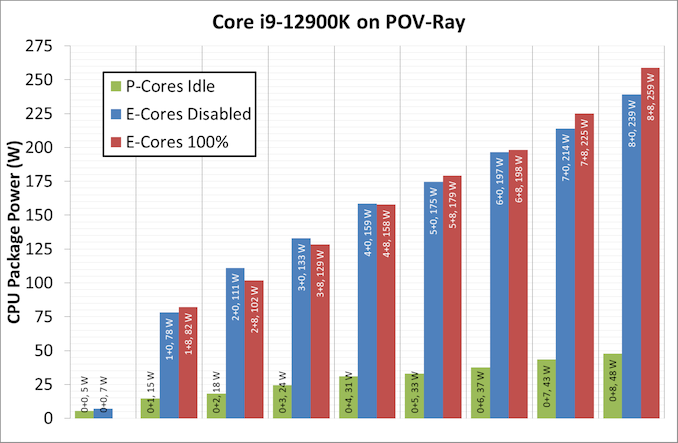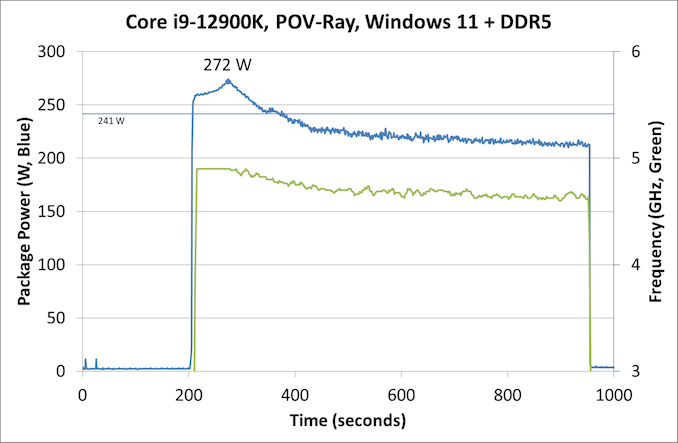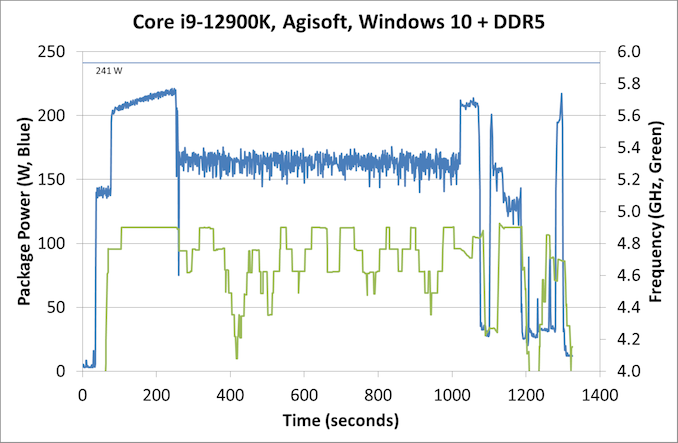The Intel 12th Gen Core i9-12900K Review: Hybrid Performance Brings Hybrid Complexity
by Dr. Ian Cutress & Andrei Frumusanu on November 4, 2021 9:00 AM ESTPower: P-Core vs E-Core, Win10 vs Win11
For Alder Lake, Intel brings two new things into the mix when we start talking about power.
First is what we’ve already talked about, the new P-core and E-core, each with different levels of performance per watt and targeted at different sorts of workloads. While the P-cores are expected to mimic previous generations of Intel processors, the E-cores should offer an interesting look into how low power operation might work on these systems and in future mobile systems.
The second element is how Intel is describing power. Rather than simply quote a ‘TDP’, or Thermal Design Power, Intel has decided (with much rejoicing) to start putting two numbers next to each processor, one for the base processor power and one for maximum turbo processor power, which we’ll call Base and Turbo. The idea is that the Base power mimics the TDP value we had before – it’s the power at which the all-core base frequency is guaranteed to. The Turbo power indicates the highest power level that should be observed in normal power virus (usually defined as something causing 90-95% of the CPU to continually switch) situation. There is usually a weighted time factor that limits how long a processor can remain in its Turbo state for slowly reeling back, but for the K processors Intel has made that time factor effectively infinite – with the right cooling, these processors should be able to use their Turbo power all day, all week, and all year.
So with that in mind, let’s start simply looking at the individual P-cores and E-cores.
Listed in red, in this test, all 8P+8E cores fully loaded (on DDR5), we get a CPU package power of 259 W. The progression from idle to load is steady, although there is a big jump from idle to single core. When one core is loaded, we go from 7 W to 78 W, which is a big 71 W jump. Because this is package power (the output for core power had some issues), this does include firing up the ring, the L3 cache, and the DRAM controller, but even if that makes 20% of the difference, we’re still looking at ~55-60 W enabled for a single core. By comparison, for our single thread SPEC power testing on Linux, we see a more modest 25-30W per core, which we put down to POV-Ray’s instruction density.
By contrast, in green, the E-cores only jump from 5 W to 15 W when a single core is active, and that is the same number as we see on SPEC power testing. Using all the E-cores, at 3.9 GHz, brings the package power up to 48 W total.
It is worth noting that there are differences between the blue bars (P-cores only) and the red bars (all cores, with E-cores loaded all the time), and that sometimes the blue bar consumes more power than the red bar. Our blue bar tests were done with E-cores disabled in the BIOS, which means that there might be more leeway in balancing a workload across a smaller number of cores, allowing for higher power. However as everything ramps up, the advantage swings the other way it seems. It’s a bit odd to see this behavior.
Moving on to individual testing, and here’s a look at a power trace of POV-Ray in Windows 11:
Here we’re seeing a higher spike in power, up to 272 W now, with the system at 4.9 GHz all-core. Interestingly enough, we see a decrease of power through the 241 W Turbo Power limit, and it settles around 225 W, with the reported frequency actually dropping to between 4.7-4.8 GHz instead. Technically this all-core is meant to take into account some of the E-cores, so this might be a case of the workload distributing itself and finding the best performance/power point when it comes to instruction mix, cache mix, and IO requirements. However, it takes a good 3-5 minutes to get there, if that’s the case.
Intrigued by this, I looked at how some of our other tests did between different operating systems. Enter Agisoft:
Between Windows 10 and Windows 11, the traces look near identical. The actual run time was 5 seconds faster on Windows 11 out of 20 minutes, so 0.4% faster, which we would consider run-to-run variation. The peaks and spikes look barely higher in Windows 11, and the frequency trace in Windows 11 looks a little more consistent, but overall they’re practically the same.
For our usual power graphs, we get something like this, and we’ll also add in the AVX-512 numbers from that page:

Compared to Intel’s previous 11th Generation Processor, the Alder Lake Core i9 uses more power during AVX2, but is actually lower in AVX-512. The difficulty of presenting this graph in the future is based on those E-cores; they're more efficient, and as you’ll see in the results later. Even on AVX-512, Alder Lake pulls out a performance lead using 50 W fewer than 11th Gen.
When we compare it to AMD however, with that 142 W PPT limit that AMD has, Intel is often trailing at a 20-70 W deficit when we’re looking at full load efficiency. That being said, Intel is likely going to argue that in mixed workloads, such as two software programs running where something is on the E-cores, it wants to be the more efficient design.














474 Comments
View All Comments
JayNor - Saturday, November 6, 2021 - link
"In the aggregate scores, an E-core is roughly 54-64% of a P-core, however this percentage can go as high as 65-73%."It isn't clear what you mean here. A P-core second thread on the same core would be expected to add around 30%.
A more understandable test would something like Intel presented of Gracemont 4C4T vs Skylake 2C4T, although it would also be interesting to see performance and power of 8C8T vs 2C4T of Golden Cove, since they reportedly occupy a similar layout space.
SystemsBuilder - Saturday, November 6, 2021 - link
Really happy to see AVX-512 is available with a simple BIOS switch!This looks to me like how AVX-512 should have been implemented in Sky lake, Cascade lake and Rocket lake and now they finally are getting it right:
Alder lake seams to have:
- both AVX-512 ports enabled (port 0 and 5) !
- able to run at negative offset = 0 for both AVX2 and AVX-512!
- AVX-512 power consumption seams too be in line with AVX2!
Excellent in other words! Since the silicon is there, if they can get the scheduler to manage heterogeneous (P/E) cores there is now no down side with enabling AVX-512.
-
Oxford Guy - Saturday, November 6, 2021 - link
I guess you missed the sentence about how the MSI boards don’t have the switch, the sentence about how it’s actually not supposed to be there, and the sentence about how it could be eliminated in the future.Additionally, what high-end motherboards offer in BIOS may be more than what is offered in more affordable models. Vendors might restrict this unofficial ‘support’ to top models.
The entire situation is completely incompetent. It’s patently absurd.
Oxford Guy - Saturday, November 6, 2021 - link
It raises a very serious question about Gelsinger’s leadership.All the hype about putting an engineer in charge and we have this utter inanity as the result.
mode_13h - Saturday, November 6, 2021 - link
> It raises a very serious question about Gelsinger’s leadership.I'm sure this decision never crossed his desk. It would be made probably 2+ levels below him, in the management hierarchy.
Moreover, he's been in charge for only about 8 months or so. Do you have any idea how long it takes to steer a big ship like Intel? This decision wasn't made yesterday. It would require OS support, which means they'd have had to get buy-in from Microsoft for it, many months ago.
And that's just if you're talking about the decision not to allow partial AVX-512 enabling. The decision to exclude it from Gracemont was made many years ago. Its exclusion was possibly considered a necessity for Gracemont's success, due to the perf/area -> perf/$ impact.
Oxford Guy - Saturday, November 6, 2021 - link
If Gelsinger wasn’t aware of the lie about fusing off and all of the other critically-important aspects involved he’s either a charlatan or Intel is structurally incompetent.Wrs - Saturday, November 6, 2021 - link
Why all the fuss about a technically unsupported feature? The only consumer chips officially to have AVX-512 contain Rocket Lake cores. Not Zen 3, or 2, or Comet Lake, or Alder Lake. If you find your Alder Lake has hidden AVX-512 abilities, how's that any different from finding out you can enable 6 cores on your 4-core Celeron?mode_13h - Saturday, November 6, 2021 - link
> The only consumer chips officially to have AVX-512 contain Rocket Lake cores.Ice Lake and Tiger Lake do, but they're only in laptops, NUCs, and SFF PCs.
zodiacfml - Sunday, November 7, 2021 - link
that guy is hating on Gelsinger.Qasar - Sunday, November 7, 2021 - link
that guy hates on everything